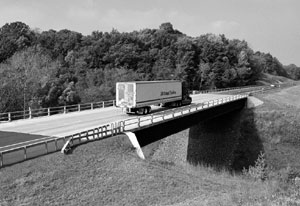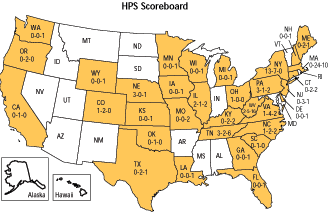U.S. Department of Transportation
Federal Highway Administration
1200 New Jersey Avenue, SE
Washington, DC 20590
202-366-4000
Focus
| Accelerating Infrastructure Innovations |
Publication Number: FHWA-RD-02-009
Date: April 2002
From Oregon to New York State, construction of high-performance steel (HPS) bridges is on the rise. Since the first HPS bridge in the United States opened to traffic in December 1997 in Snyder, Nebraska, HPS has been used in more than 150 bridges nationwide. This figure includes bridges currently in the design or fabrication stages, as well as those that have already opened. Developed through a joint effort among the Federal Highway Administration (FHWA), American Iron and Steel Institute (AISI), and the U.S. Department of the Navy, HPS (which includes grades HPS-70W and HPS-50W) is stronger and has less than 60 percent of the carbon and about 15 percent of the sulfur of conventional steel. HPS is also tougher than conventional steel and can offer greater resistance to cracking compared with conventional bridge steels.
 |
| This simple-span structure over the Berkshir Thruway in New York State was constructed using HPS-70W. |
The New York State Thruway Authority has used HPS-70W on a number of bridges, including a simple-span structure over the Berkshire Thruway and many two-span continuous structures, such as one at the I-90, Exit 54 interchange. The use of HPS-70W on the Berkshire Thruway bridge eliminated the need for an interior pier to support the superstructure between abutments. On the I-90 interchange, all components of the bridge's primary stress-carrying members were fabricated using HPS-70W, including stiffeners and connection plates. The Thruway Authority has found HPS-70W to be an excellent alternative to conventional steels. "Overall we've been very pleased with the performance. We like the increased toughness and weathering characteristics of the steel," says Peter Stapf of the Thruway Authority. The 40 percent higher yield strength of the HPS allows engineers to design longer, shallower spans, which has provided increased vertical clearance underneath the existing structures without substantial modification of the structure profile and approaches. "We consider HPS to be another tool in our box now. We have a couple of bridges currently under construction and will construct a 269-ft simple span structure later this season," says Stapf.
 |
|
States with HPS bridges. The first number indicates bridges that are in service, the second lists those in fabrication or construction, and the third number indicates bridges in planning or design. |
The HPS Steering Committee, which includes representatives from FHWA, the U.S. Navy, AISI, and the National Steel Bridge Alliance, recommends that fabrication of HPS be done using the provisions of the Guide Specifications for Highway Bridge Fabrication with HPS 70W Steel (Publication Code HBF-1). This document, published by the American Association of State Highway and Transportation Officials (AASHTO), is available from the AASHTO Publications Order Department, 800-231-3475 (Web: www.transportation.org/publications/bookstore.nsf). An HPS Designer's Guide was also released by FHWA last year, providing details on using HPS for bridges as well as contacts for more information. The guide will soon be on the Web at www.fhwa.dot.gov/bridge. From the main page, go to the "high-performance steel" link. HPS will also be the subject of an upcoming conference, "2002 FHWA Steel Bridge Conference for the Western United States." To be held December 12-13, 2002, in Salt Lake City, Utah, the conference will focus on design, fabrication, construction, and research issues related to steel bridges. For more information on the conference, contact Dr. Atorod Azizinamini at the National Bridge Research Organization, 402-472-3462 (fax: 402-472-6658; email: nabro@unlnotes.unl.edu).
The map (above), which was developed by the HPS Steering Committee, shows the status of HPS bridge building and design across the country. To learn more about completed and planned HPS projects, visit the HPS Scoreboard at www.steel.org/infrastructure/sbf/hps_scoreboard_ 1100.xls.
For more information, contact Krishna Verma, Senior Welding Engineer in the Office of Bridge Technology at FHWA, 202-366-4601 (fax: 202-366-3077; email: krishna.verma@fhwa.dot.gov). For more information on the bridges built by the New York State Thruway Authority, contact Peter Stapf at 518-471-4255 (email: peter_stapf@thruway.state.ny.us).